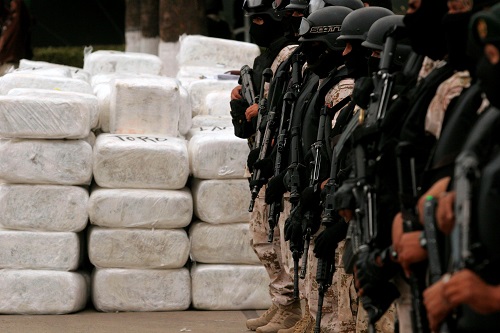Reuters photo
By
Ricardo Swire
Simply a transit point in the 1990s, Argentina is now the second largest regional drugs market after Brazil.
Drugs trafficking responds to the logic of globalization and does not recognize boundaries. A United Nations Office on Drugs & Crime (UNODC) report noted Argentina accounts for twenty-five percent of Latin American and Caribbean cocaine consumption. Argentina’s level of use five time higher than the regional average. Secret drug labs were found by law enforcement in 2014.
In one trafficking scenario Argentinian counter-narcotics agents seized seven pounds of marijuana, stashed in a residence located in Posadas, across the Parana River from Paraguay. On another occasion a Gendarmerie Corporal was detained, after one hundred and ten kilos or two hundred and forty-three pounds of cocaine were discovered in the law enforcer’s car. An Argentinian government ambulance intercepted transporting twenty-five kilos or fifty-five pounds of cocaine, the emergency service vehicle’s siren blaring and a patient aboard when stopped.
In May 2016 “Operation Fronteras” or “Border Operations” applied interdiction technology and increased use of Argentina’s military in counter-narcotics offensives. The country’s internal security officials reported drug interdiction efforts, against both fluvial and land based trafficking, recorded a sudden escalation of drug planes. As of November 2016 forty suspect flights from Bolivia alone were intercepted. Between January and April 2017 two hundred drug flights were detected in Argentinian airspace, a threefold increase over the same period for 2016.
Local law enforcers have discovered one thousand five hundred clandestine airstrips to date, a trend of stolen small planes, from Federación de Aeroclubes de Argentina (FADA), also developed. Such preferred category of aircraft has the capability to transport half a metric ton of cocaine per flight. Additionally, the small plane only requires three hundred meters of runway to land and take off. As of May 2017 Argentina’s US$46 million “Land Border Control Initiative” was still not introduced by political bureaucrats.
Regional intelligence analysis suggests improved radar coverage, coupled with drug trafficking’s expansion, share responsibility for the underworld’s adjusted tactics and Argentina’s importance. Counter-narcotics enforcement modification along the northbound route, as well as in Brazil and Chile, placed Argentina in next best trafficking position. Argentina’s geography comprises five thousand eight hundred miles of land border and approximately three thousand two hundred miles of coastline.
Shipping routes bisect the Rio Parana that connects Brazil to Argentina via Paraguay. This route also facilitates the cities of Santa Fe and Rosario. As part of the “Balloon Effect” drug cartels headquartered in Brazil, Colombia, Italy and Mexico have established operational platforms in Argentina. “The Dagger,” a notorious thirty-nine year old male Colombian trafficker, possessed three Argentinian passports under bogus names. The underworld character changed his Buenos Aires residential address three times, while performing the role of assassin for “The Crazy One,” a feared Colombian trafficker.
Ricardo Swire
Ricardo Swire is the Principal Consultant at R-L-H Security Consultants & Business Support Services and writes on a number of important issues.



No Comments Yet!
You can be first to comment this post!